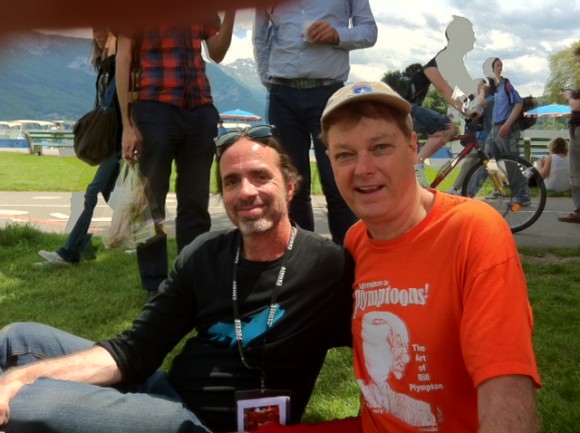
Bill Plympton with Chris Landreth
BILL PLYMPTON is the Oscar-nominated filmmaker of seven animated features and more than thirty animated shorts. His new feature Cheatin’ will premiere this fall. Learn more about his work at Plymptoons.com.
I went to Annecy with mixed emotions this year—after all, it was a year of major changes.
The iconic Bonlieu Centre, where all the action usually takes place, was being torn down to be replaced by a larger and hopefully more beautiful structure. Some say the new theater complex will be finished next year and some say in two years—who knows, with French construction workers.
The other new kink was the fact that celebrated artistic director Serge Bromberg was leaving after fifteen wonderful years, to be replaced by Marcel Jean. So, naturally, I felt that this would be a transitional year.
My wife Sandrine and I arrived just in time to go to the opening night event, taking place in the freshly-constructed hybrid tent cinema. The opening film was the long anticipated Pixar sequel Monsters University, directed by Dan Scanlon, along with the new Pixar short Blue Umbrella. The latter six-minute short by Saschka Unseld had a very different look from all of the former Pixar shorts, a lot more realistic, and the love story involving two colored umbrellas in a rainstorm has certain similarities to last year’s Oscar winner, Paperman.
Monsters University was a bit disappointing—for me there were too many extraneous characters to get emotionally involved, and the colors, especially the backgrounds on the campus grounds, were too neon-bright, which made it hard to enjoy the beautiful design and follow the characters.
The next morning I had a panel about crowdfunding and Kickstarter. Like a similar panel I hosted at Stuttgart, it was a packed house. After years of sucking off the government teat, the Europeans are mad for a more democratic, and perhaps hassle-free, way for raising money to make films.
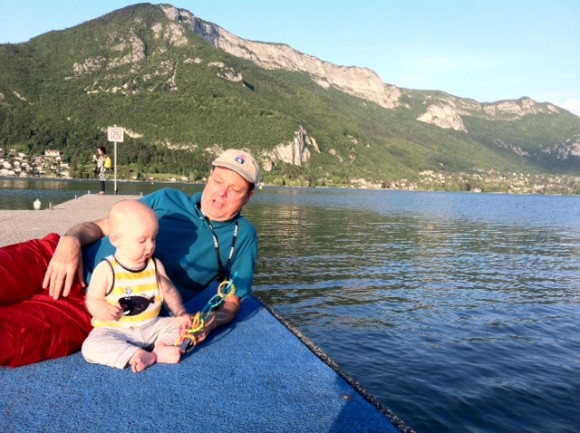
Bill Plympton with his son Lucas Plympton
Tuesday afternoon was the Competition Shorts creening #2, and my film Drunker Than a Skunk was in that group, so Sandrine and I needed to attend to present the film. The program started off promisingly enough—meaning that the films were not that good and hence the audience would love our film. All the early films in the program were abstract or avant-garde, therefore not crowd-pleasers. Then came Remi Vandenitte’s Betty’s Blues, a wonderful ode to Southern blues music that had a terrific style. Then Drunker came on and we received a very nice reaction. We felt we were looking good for Awards Night.
But, later in the program, came Chris Landreth’s unmemorably named Subconscious Password, a totally delightful and bold CG film starring Chris and the enigmatic John Dilworth. Then and there, I knew our awards chances flew out the window. Oh well, once I knew I didn’t have to worry about awards, I could just enjoy the week and relax.
My next event was a work-in-progress screening of my new feature, Cheatin’. There was a really good buzz going about this film, so tickets were hard to get and a lot of people asked me to sneak them in.
I showed some pencil tests and finished scenes, drew some of the character designs and talked about the production. The audience applauded throughout (which I loved) and then I moved to a table just outside the exit, next to a beautiful creek, and gave everyone in line a free sketch, which took about an hour.
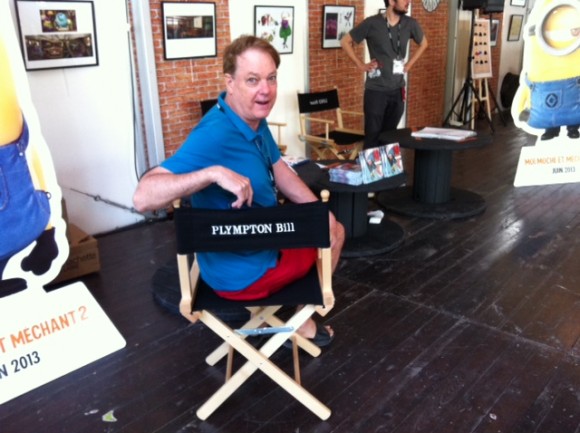
For the past seven years, I’ve been presenting the “Annecy Plus” show, first with Pat Smith, and now with Nik and Nancy Phelps. It’s been a smashing success. This year, we were forced to relocate the popular event to the wonderful Café des Arts in Old Town. We promoted the hell out of it, and the weather was perfect so we had high hopes for a big success. Unfortunately, there was no movie screen!
Jonas Raeber, the projectionist and sound man, was able to “borrow” two large sheets from his hotel. Another problem: the door with access to the balcony, where we wanted to hang the sheets, was locked with no key. So, a drunk Indian animator volunteered to leap from an open window across to the balcony—a real Jackie Chan-type moment. I had visions of a terrible accident, and me spending three years in French courts fighting a lawsuit, but the dashing Indian succeeded, and he had free beers all night.
Nik Phelps and his band kicked off the evening with some lively music, and we began the show. Then, the next tragedy struck. Even though Virginia, the proprietor of the bar, had received permission from the city council to hold a late-night screening, there was a rave the night before and it created such a ruckus that her permit was revoked. Thus, we had to turn the sound off at 10p.m., and the problem with that was that it didn’t get dark until 9:30. As a result, the audience only heard one out of the four programs—the last three were silent. Quel dommage.
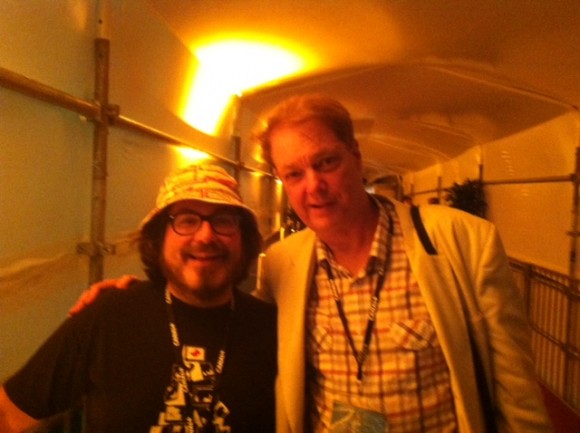
Bill Plympton with Titmouse’s Chris Prynoski
However, there was enough beer and wine for everyone, and a good time was had by all. The Annecy Plus winning film, by the way, was Super by Johan Klungel. As for the main Annecy awards show, it was a happy affair with nice weather, and Serge showed up to give out the awards with Marcel Jean. The big winner of the evening, and justifiably so, was Subconscious Password by Chris Landreth. He gave a fantastic speech, then we all went to party at the Palais, where I visited with Eric Goldberg, Bill Kroyer, Chris Prynoski of Titmouse Studios, Dominique Puthod (the president of the festival), Chel White, and Michaela Pavlatova, last year’s winner with Tram.
The best news was that everyone was talking about Cheatin’, so chances are good it will be in competition next year in Annecy. See you all there!
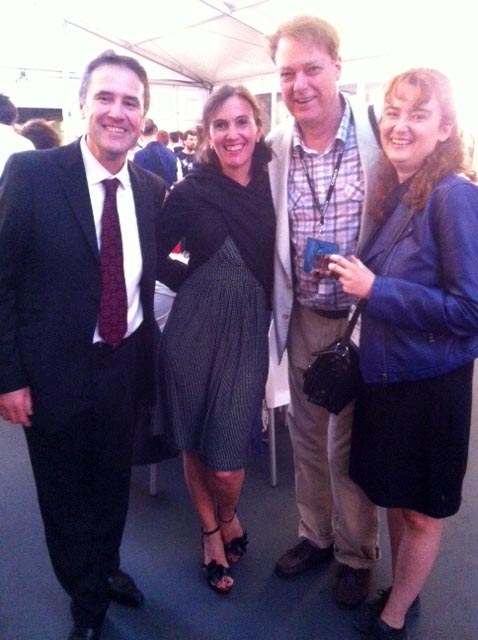
Dominique Puthod (Annecy Festival President), his wife Catherine, Bill and
Sandrine Plympton
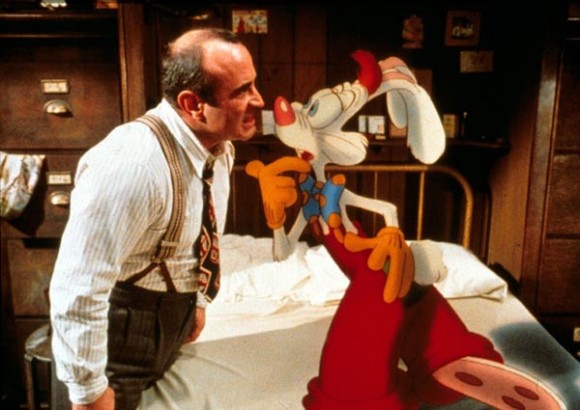
ROSS ANDERSON is currently writing the definitive book about the making of Roger Rabbit, beginning with Gary K. Wolf’s novel and Disney’s early Roger Rabbit development unit, continuing with the production of “Who framed Roger Rabbit”, and through the follow-up shorts, merchandising and theme park presence, and development work on sequels. He wrote this piece exclusively for Cartoon Brew about the 25th anniversary screening of “Roger Rabbit” that took place last week in Los Angeles.
On Thursday evening, April 4th, the Academy of Motion Picture Arts and Sciences hosted the first public screening of the new digital print of Who framed Roger Rabbit. The preparation of the digital print coincides with the release of the 25th anniversary Blu-ray edition of the film , and the Academy hosted a terrific show.
, and the Academy hosted a terrific show.
When the tickets were made available on-line they sold out within a day or two. The film was enormously popular when it was released and it has been a touchstone for film and animation enthusiasts ever since. I can’t take credit for the touchstone/Touchstone remark—that came from Rich Moore, director of Wreck-It Ralph, who was the moderator of the panel discussion that followed the film screening.
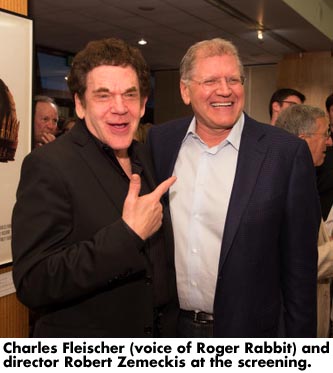 The event attendees were polite and mature in their behavior, although many of them hadn’t been born when the film was released. The enthusiasm for the film has some of the earmarks of coltishness, but it is not as though the adoration is a personal ‘find’ and a delight against all reason. There are ample reasons to delight in the film, and everybody has their own joys that they find in it. Mine – is that I had been a life-long animation enthusiast who found it difficult to share my enthusiasm with friends. I was in university when Robin Hood was released. I would have been harassed unmercifully if my interest in Disney animation had become known to my dorm-mates. Who framed Roger Rabbit made animation ‘cool’ again…and it made money, which increased the enthusiasm of the studios. Many people in the animation industry credit the film with ushering in a silver age of feature animation.
The event attendees were polite and mature in their behavior, although many of them hadn’t been born when the film was released. The enthusiasm for the film has some of the earmarks of coltishness, but it is not as though the adoration is a personal ‘find’ and a delight against all reason. There are ample reasons to delight in the film, and everybody has their own joys that they find in it. Mine – is that I had been a life-long animation enthusiast who found it difficult to share my enthusiasm with friends. I was in university when Robin Hood was released. I would have been harassed unmercifully if my interest in Disney animation had become known to my dorm-mates. Who framed Roger Rabbit made animation ‘cool’ again…and it made money, which increased the enthusiasm of the studios. Many people in the animation industry credit the film with ushering in a silver age of feature animation.
Academy member and veteran animation director Bill Kroyer introduced the screening. Bill was a young animator at the Disney studio prior to the first onslaught of CalArts grads, who included John Lasseter, Tim Burton, Brad Bird, Henry Selick, John Musker, Jerry Rees, and Darrell Van Citters. They were all frustrated with how Disney animation was functioning in the early-1980s.
Tom Wilhite, the young Disney Live-Action Studio Head, saw their frustration and did what he could to enable projects that would satisfy their creative juices and keep them at the studio. Aside from John Musker, they were all eventually fired or left the studio of their own accord, but out of that early grouping came Tim Burton’s Vincent and Frankenweenie and John Lasseter’s The Brave Little Toaster, which Wilhite eventually produced, with Jerry Rees directing, as ‘Hyperion Pictures’, after he, too, left Disney. Wilhite also brought Tron to the Disney studio and was responsible for setting up the Roger Rabbit development unit at Disney in 1981, helmed by Darrell Van Citters.
Bill Kroyer was one of the first ‘animators’ to do computer animation. He and Jerry Rees were assigned to the Tron production to work with the early CGI providers. The computer software at that time was not intuitive at all, so there was more hand-drawn ‘logistical guidance’ for the programmers than most people realize. That was Bill and Jerry. Their involvement also fired up John Lasseter’s interest in computer animation. The Brave Little Toaster was intended to be the first full length CGI animated feature.
Tom Wilhite sent memos to scoop up Bill Kroyer, Jerry Rees, John Lasseter, Ron Clements, Mike Gabriel, Randy Cartwright, and Glen Keane for the Roger Rabbit unit… Wouldn’t that have been something?
Tron was released in 1982, at a time that the Darrell Van Citters’ Roger Rabbit development unit was getting into full swing. Screenwriters Peter Seaman and Jeffrey Price had just come off of Trenchcoat, a Disney mystery/comedy, and Wilhite assigned them to prepare a screenplay for Roger Rabbit. At that time Wilhite also sent memos to Darrell and Marc Stirdivant, the Disney house producer assigned to the development unit, to scoop up Bill Kroyer, Jerry Rees, John Lasseter, Ron Clements, Randy Cartwright, Mike Gabriel, and Glen Keane for the Roger Rabbit unit. Other things were happening at the studio, and soon most of those people were gone… but wouldn’t that have been something?
Back to the screening – Bill Kroyer called out many of the attendees who had been instrumental in making the film. This list isn’t exhaustive, but those who did stand up included voice actors Charles Fleischer (Roger Rabbit, Benny the Cab and others), June Foray (Lena Hyena), and Tony Anselmo (Donald Duck), animators Andreas Dejas and Nik Ranieri, screenwriters Seaman and Price, editor Artie Schmidt, London studio manager Max Howard, producers Steve Starkey and Don Hahn, and, of course, director Bob Zemeckis.
The film screening was wonderful. The digital print was clear and fresh and the colors popped out at you. Not having seen the film on the big screen for twenty-five years, I found it difficult to discern whether the viewing pleasure was due to anything particular associated with the digital print or simply that I was sharing the big screen experience with a room full of similarly enthusiastic viewers. The quality aspects of the digital restoration were being hotly debated within knots of people after the screening was over.
A panel discussion followed the screening. It was hosted by Rich Moore and included Peter Seaman, Jeffrey Price, Andreas Deja, Charles Fleischer, Joanna Cassidy, Steve Starkey, Bob Zemeckis, and Don Hahn. There were many reminiscences from the production. Most of them were well known to the real Roger Rabbit enthusiasts, but the ones who resonated the most for me were those that put the ‘25-years’ into perspective. We have heard about Who framed Roger Rabbit having way more special effects than Star Wars, but it was also one of the last of the great ‘optical’ effects films. It was a different era.
Zemeckis reminisced that, “we had FedEx and ¾” tape – we had technology by the tail.” He spoke about the first finished animation that came over from the London studio unit. It was the portion of the introductory Something Cookin’ cartoon in which the chili sauce falls off the shelf in Roger’s kettle-head. The British animators spelled ‘chili’ in the British manner, with two l’s (‘chilli’). The scene had to be completely re-animated.
In the scene which the camera trucks over the newspaper headlines showing the Toon cases solved by Valiant & Valiant on Eddie’s desk, the London studio had used the banners of LA newspapers of the time (1947), without having asked permission of the newspapers. One newspaper ended up refusing permission to use their banner – and this complicated scene had to be completely re-shot. Another anecdote was that Paul Newman had been considered for the role of Eddie Valiant. Charles Fleischer immediately shot back that Judge Doom would then have had to use ‘dressing’ instead of ‘dip’.
The greatest benefit of the digital presentation was the close-ups on the actors’ faces…there was sublime acting and emotion that contributed enormously to the ‘reality’ of their interaction with the ’toons.
Don Hahn made a call out for Richard Williams, who recently celebrated his 80th birthday. Richard had hoped to attend but was unable to make it. Also, during the panel discussion, it became clear that the presence of Bob Hoskins was greatly missed. He was universally acclaimed for his work on the film. I must say that the greatest benefit that I saw with the digital presentation was in the close-ups on the actors’ faces. There was sublime acting and emotion that contributed enormously to the ‘reality’ of their interaction with the ’toons. We ‘felt’ it and it was an integral aspect of the great ‘conceit’ of the live-action/toon combination, but the subliminal effects were often lost in the chaos of the action. In this viewing, they popped out at me.

It was a great night. Following the conclusion of the panel discussionm, the many Roger Rabbit production participants reunited on stage to catch up on 25 years. The ‘celebrities’ amongst them were cornered for autographs, and the ‘no photography’ policy of the Academy theater was completely thrown out the window as the hundreds of cameras that were spirited into the theater finally came out.
A group shot was hastily organized and there were many more Roger Rabbit alumni present than had been called out during the evening’s introduction. I counted at least twenty-five alumni. I had the pleasure of speaking to many of them and seeing several of them the next day. It was a special night for Roger Rabbit fans and a special night for those who were involved in making it.









 The event attendees were polite and mature in their behavior, although many of them hadn’t been born when the film was released. The enthusiasm for the film has some of the earmarks of coltishness, but it is not as though the adoration is a personal ‘find’ and a delight against all reason. There are ample reasons to delight in the film, and everybody has their own joys that they find in it. Mine – is that I had been a life-long animation enthusiast who found it difficult to share my enthusiasm with friends. I was in university when Robin Hood was released. I would have been harassed unmercifully if my interest in Disney animation had become known to my dorm-mates. Who framed Roger Rabbit made animation ‘cool’ again…and it made money, which increased the enthusiasm of the studios. Many people in the animation industry credit the film with ushering in a silver age of feature animation.
The event attendees were polite and mature in their behavior, although many of them hadn’t been born when the film was released. The enthusiasm for the film has some of the earmarks of coltishness, but it is not as though the adoration is a personal ‘find’ and a delight against all reason. There are ample reasons to delight in the film, and everybody has their own joys that they find in it. Mine – is that I had been a life-long animation enthusiast who found it difficult to share my enthusiasm with friends. I was in university when Robin Hood was released. I would have been harassed unmercifully if my interest in Disney animation had become known to my dorm-mates. Who framed Roger Rabbit made animation ‘cool’ again…and it made money, which increased the enthusiasm of the studios. Many people in the animation industry credit the film with ushering in a silver age of feature animation.